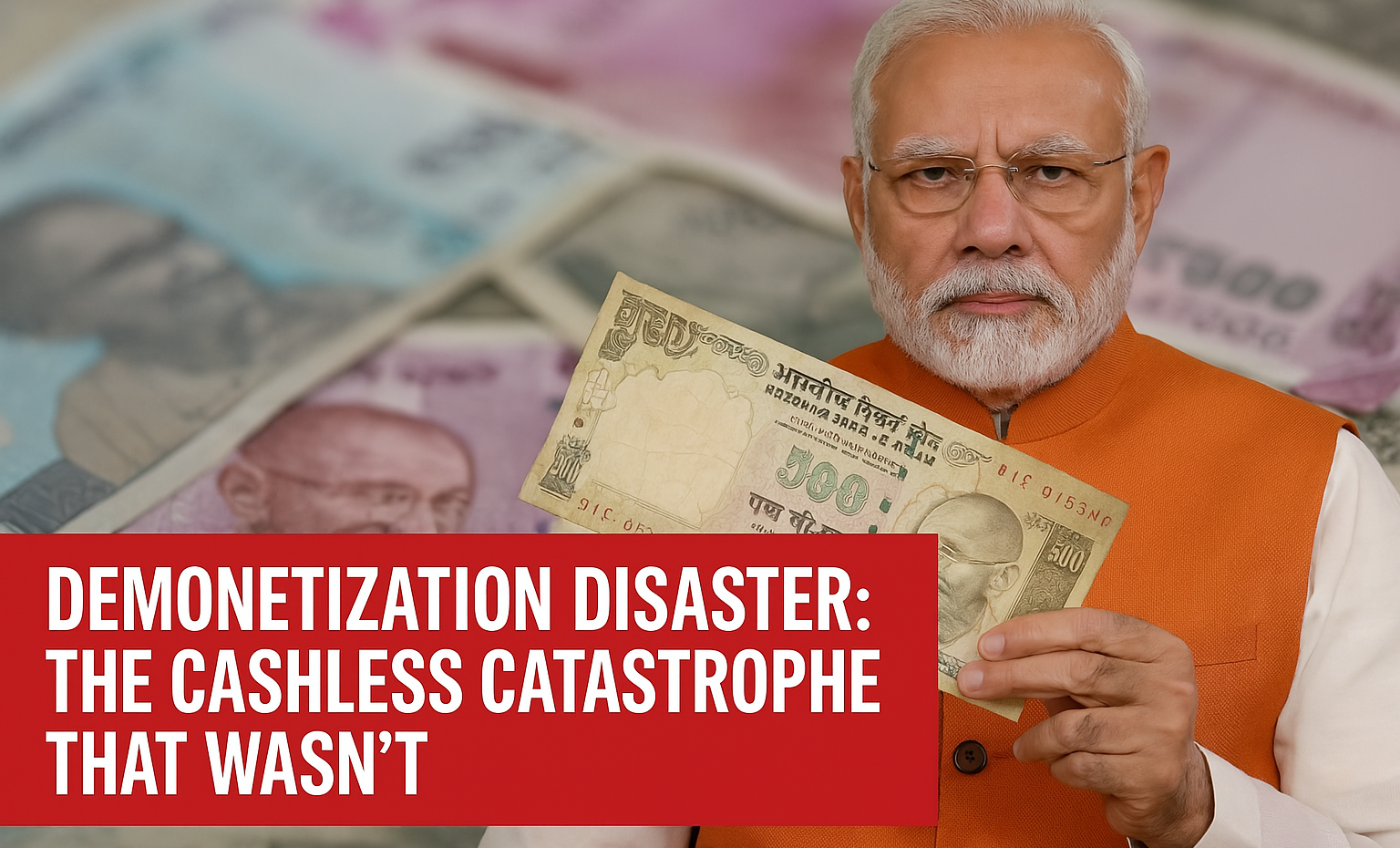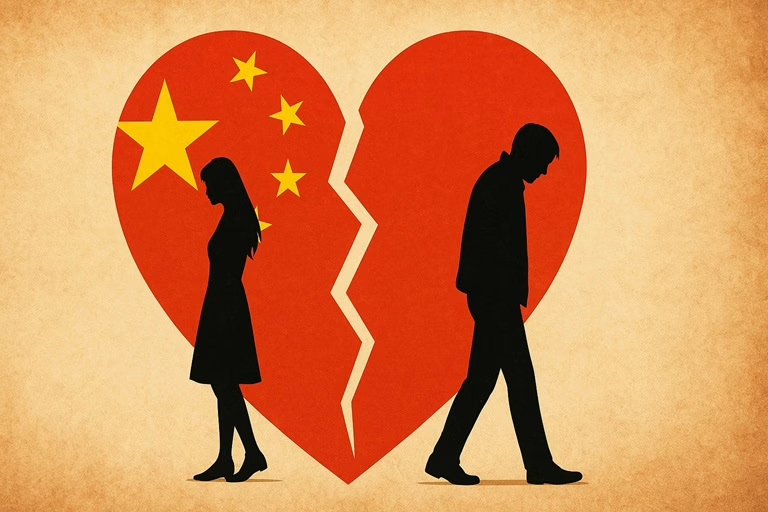A lone man wanders a rural Chinese village – emblematic of the country’s 35 million “leftover men” who face a bride shortage after decades of one-child policy. Exorbitant bride prices and changing social norms fuel China’s marriage crisis.
Once upon a time in China, getting married was as natural as breathing – a near-universal rite of passage rooted in thousands of years of tradition. Families would rejoice, fireworks would light up the village sky, and the union of two people was seen as the bedrock of society. Fast-forward to today, and the wedding bells are falling silent. Marriage in China has plunged into a crisis: young people are increasingly saying “Meh” instead of “I do,” marriage registrations have nosedived, and divorce rates (while recently tempered by legal hurdles) remain high. The result? A looming demographic nightmare featuring a rapidly aging society, fewer babies, and a generation of so-called “leftover” men and women left in marital limbo. It’s as if the Cupid of the East has gone on strike – and the implications are profound, reaching from lonely hearts to the highest levels of Beijing’s policy-making.
Tying the Knot? Not So Much – A 60% Collapse in Marriages
China’s marriage rate has been in free fall, and the statistics are jaw-dropping. In 2024, only 6.1 million couples registered their marriages – the lowest number in four decades. To put that in perspective, that’s barely half of the 13.5 million weddings that took place in 2013 when marriages peaked. Indeed, over the past decade, new marriages have plummeted by about 55%, an unprecedented collapse in a country that not long ago considered marriage virtually mandatory by one’s late 20s. This isn’t a slow gradual decline; it’s a cliff. In 2024 alone, marriages fell 20.5% from the previous year’s. You know it’s bad when even state-run media calls it “falling off a cliff since 2013.”
What’s driving this great marital retreat? Several converging trends. Youth priorities have shifted – more young Chinese are pursuing higher education and careers, and marrying late or not at all. The old social stigma around being single at 30 has weakened (though not vanished), especially in cosmopolitan cities where single life is increasingly accepted. Economic pressures also loom large. Many cite the high cost of housing, education, and general living as reasons to postpone marriage. It’s hard to save for a wedding (and a home, which is almost a de facto prerequisite for marriage in China) when you’re barely scraping by in an uber-competitive urban job market. And for the men, there’s the intimidating hurdle of the bride price – more on that in a moment – which in some cases has turned marriage into a financial transaction few can afford.
Compounding these is a shrinking pool of young people to even pair up. Thanks to the one-child policy (in effect from 1980 to 2015) and recent ultra-low birth rates, China simply has fewer 20- and 30-somethings now. The cohort that would traditionally be marrying is a smaller slice of the population than in prior generations. Less supply of marriageable age folks, fewer marriages – brutal demographics at work.
Beijing is alarmed, because in China marriage and childbirth are tightly linked – about 95% of babies are born in wedlock. Fewer marriages today means even fewer births tomorrow, worsening the demographic decline. The year 2022 already saw China’s population shrink for the first time since the Great Famine of the 1960s. In 2024 there was a short-lived uptick in births (9.5 million babies, slightly up from 2023’s 9.0 million), but that was largely attributed to it being the auspicious Year of the Dragon, which prompted couples to time babies accordingly. Demographers warn that this dragon-year blip is temporary and that births will resume their downward spiral, especially if marriages keep falling. The Chinese zodiac might influence some, but it can’t overcome the structural forces keeping young Chinese single.
Divorce: For Richer or Poorer, ’Til the Courts Do Part
On the flip side of this marital malaise is divorce. For a few decades, as marriages soared through the 80s, 90s and 2000s, divorces climbed too – reaching a peak in the late 2010s. By 2019, China was recording over 4 million divorces a year, a massive change from the near-zero rates in the Mao era (when divorce was stigmatized and hard to obtain). In fact, the ratio of divorces to marriages rose sharply; by around 2019, there was roughly 1 divorce for every 2 marriages annually, or ~45%. Some unofficial estimates suggested it approached 50% – meaning nearly half as many divorces as new marriages in a given year. The user’s question mentioned divorce rates “increased to 57%” – this might refer to a specific stat (possibly a particular city or just an exaggerated figure). While 57% isn’t an official nationwide metric, it captures the perception that divorces became alarmingly common.
The government grew concerned that easy divorces were undermining family stability. So, in 2021 they introduced a “cooling-off period” – basically a mandatory 30-day wait after filing, meant to discourage impulsive breakups. This policy, combined with the pandemic and some administrative hurdles, actually led to a drop in recorded divorces in 2021-2022 (a somewhat Pyrrhic victory: it might have just delayed or deterred unhappy couples). By 2024, divorces ticked back up slightly to 2.82 million. So while divorce numbers aren’t skyrocketing further (partly due to fewer people marrying in the first place), China still witnesses millions of marital dissolutions each year, and many observers note that divorce has lost much of its stigma among younger generations. Especially in urban areas, women in particular are more willing to exit bad marriages, empowered by education and incomes that their mothers or grandmothers lacked.
This mix – fewer marriages and many divorces – implies that at any given time, a larger share of Chinese adults are single (never married or divorced) than ever before. This is historically unprecedented in China. In the past, being unmarried by your 30s made you an odd duck (hence the old derogatory term “剩女” – shèngnǚ, or “leftover woman” – for single women over 27). Now, those “leftovers” are a sizeable demographic in their own right, challenging social norms. And it’s not just women; in fact, “leftover men” (剩男) are the bigger story in terms of numbers.
The Leftover Men and Lonely Women: Gender Imbalance Woes caused by China’s Marriage Crisis
China’s one-child policy and a cultural preference for sons created a demographic time bomb: about 30-35 million more men than women in the population are now of marriageable age. Imagine a country roughly the size of Canada composed entirely of bachelors – that’s the scale of the issue. These are the “leftover men” who struggle to find brides, particularly in rural areas. In some villages, you’ll find clusters of bachelors in their 30s and 40s who have never married because there simply aren’t enough women. The imbalance is most acute in the countryside because many women “marry up” or urbanize, leaving rural men high and dry. By 2020, the census showed a surplus of nearly 35 million males. This stark reality has even led some academics to float (controversial) ideas like “importing brides” from abroad to address the gap – a suggestion that sparked outrage, as it smacks of treating women as commodities and raises ethical issues (not to mention echoes of human trafficking, which sadly is a real problem given the demand).

Then there are the “leftover women”, typically referring to educated urban women over 25-27 who are single. The term itself was part of a state media narrative in the 2000s, almost pressuring women to settle down early. But times are changing – many of these women reject the label and are choosing single life or delayed marriage on their own terms. Sociologically, what’s happening is a mismatch: educated women often prefer partners of equal or higher status, but many high-status men still prefer younger, perhaps less career-oriented women. The result? A portion of high-achieving women remain single (some happily so) while many lower-educated, poorer men (especially rural) remain single involuntarily. It’s like an upside-down triangle in the marriage market – and it’s a hard problem to fix with policy levers.
One cause and consequence of this marriage squeeze is the skyrocketing bride price (彩礼, caili) in many regions. This is the money or goods a groom’s family gives to the bride’s family – traditionally a token of goodwill, but now often an exorbitant “marriage entrance fee.” In some rural areas, bride prices have reached astronomical levels, fueling resentment and even poverty. For example, in parts of Jiangxi province, the going rate for a bride exceeded 300,000 RMB (about $50,000) by 2023. Nationally, the average bride price was estimated around 69,000 RMB (~$9,500) in 2023 and climbing Families literally take on debt to get their son married – there are cases of farmers selling their cattle or taking high-interest loans to afford a daughter-in-law. The situation got so extreme that some locales introduced “bride price loans” (one bank offered up to 300,000 RMB financing for marriages!), and local authorities started campaigns to cap or discourage lavish bride pricess. Gansu province, for instance, issued guidelines suggesting a cap of 60,000 RMB – still a hefty sum, but far less than the previously common six-figure demands. These efforts have met mixed success; cultural expectations are hard to legislate away, and with women in short supply, the market dynamics unfortunately favor higher “prices.”
The bride price inflation also reflects a commodification of marriage that is leaving a sour taste. Many young Chinese joke that they can’t afford to marry even if they wanted to. A viral social media post listed the “going rates” for brides in various provinces, sparking debates on whether love could survive in the face of such materialism. On the flip side, some women argue the bride price is their family’s way of ensuring she’s valued and financially secure, especially in a society without robust rural pensions – it’s a payment to the bride’s parents who raised her. Both perspectives underscore that marriage in China often involves not just two individuals, but two families negotiating an alliance, almost like days of old.
Consequences of China’s Marriage Crisis: A Demographic and Economic Time Bomb
The implications of these trends are far-reaching. Demographically, this is a slow-moving trainwreck: fewer marriages -> fewer births -> faster aging -> smaller workforce -> potential economic stagnation. China’s fertility rate around ~1.2 is already among the world’s lowest, and unless the marriage trajectory changes or extramarital childbearing becomes more acceptable (currently it’s quite rare due to social norms and lack of legal status for children born out of wedlock), it’s hard to see a baby boom on the horizon. The government can and has tried many things: three-child policy (up from one-child, but it turns out you can’t mandate people to want kids), incentives like baby bonuses and housing perks for young couples, propaganda campaigns extolling motherhood, even cracking down on the “bride price” culture to reduce barriers to marriage. Some cities organize dating events or matchmaking corners to help lonely hearts meet (picture Communist Party-sponsored speed dating!). Yet, the results so far are meager. People’s personal aspirations have evolved beyond the Party’s old family planning slogans, and that genie doesn’t go back in the bottle easily.
Economically, an aging, shrinking population means China could face labor shortages and slow growth like Japan – but at a much lower level of wealth per capita than Japan had when it aged. The “demographic dividend” that powered China’s boom in the 90s and 2000s is effectively over. There’s also the question of caring for the elderly: fewer children means the traditional model of kids looking after parents in old age is under strain. By 2030, China will have hundreds of millions of senior citizens, and a smaller base of working-age people to support them, both via pension systems and within families. Some sociologists worry about a rise of elderly poverty and isolation, especially as the single-child generation grapples with supporting two parents and four grandparents (“4-2-1” family structure). The state may have to divert more resources to healthcare and pensions, potentially at the expense of other investments.
Socially, the marriage crisis could lead to instability. Large numbers of involuntarily single men, especially those who are less educated and economically insecure, historically have been associated with unrest (there’s a hypothesis in political science that excess males can lead to higher crime and even war – though we won’t over-speculate here). The Chinese government is certainly aware of this risk. There have been instances of public anger – for example, in some towns, if local officials are seen as not curbing exploitative bride prices or if incidents of bride trafficking come to light, it can cause uproar. Yes, bride trafficking is a dark reality: the shortage of women has led to cases of women being kidnapped or lured from other countries (Vietnam, Myanmar, North Korea) to be sold as brides in China. The authorities officially crack down on it, but as long as demand outstrips supply, such criminal enterprises find a way. It’s a human tragedy and a direct consequence of the demographic skew and pressure on men to find wives at any cost.
Women, on the other hand, are increasingly vocal about their rights in marriage and divorce. The days when a woman would be stigmatized for divorce or pressured to stay in an abusive marriage are fading (not gone, but certainly less). That empowerment is a net positive, but it also means the state can’t rely on patriarchal norms to prop up marriage rates. This is a more individualistic generation, and they won’t marry or have kids unless they want to. “No marriage, no children” has become a common personal choice, even a phrase seen on Chinese social media reflecting young folks’ disillusionment with the relentless rat race. As one viral post put it: “Why marry? So our kid can do 12 hours of homework a day and fight for a job till 10 p.m. like us? Nah.” It was dark humor, but it resonated widely.
India’s Angle: Parallels and Contrasts
For India, observing China’s marriage and demographic trends is like seeing an alternate future – one that India might avoid or fall into, depending on choices made. India’s demographic trajectory is quite different at the moment – a younger population, a still-rising number of marriages (though urban Indians too are marrying later than before), and a birth rate just about at replacement (2.0) but declining. If anything, India’s concern is stabilizing population growth, whereas China’s is population collapse. However, there are cautionary tales India can heed:
- Gender Balance: India also has a gender imbalance (though not as skewed as China’s). Practices like sex-selective abortion have led to more males than females in some states. China’s struggles show the long-term societal cost of such imbalance. India needs to continue addressing this via campaigns (“Beti Bachao, Beti Padhao” i.e. save the daughter, educate the daughter) and enforcement of laws against gender determination. A society with millions of frustrated single men is not a happy scenario for any country.
- Urbanization and Social Support: Part of why Chinese are avoiding marriage is the high cost urban life and lack of support for young families (like expensive daycare, punishing work hours). India’s cities are also expensive relative to incomes, and the extended family support system is weakening with nuclear families. Policymakers might consider how to make it easier for young couples to start families – whether through affordable housing programs, tax breaks, or strengthening community support systems – lest a similar trend of marriage aversion takes root among India’s urban millennials.
- Cultural Evolution: China’s experience underscores how quickly social norms can change when education and economic conditions change. India too is seeing more young people prioritize careers and personal freedom, and the stigmas around being single or divorced are slowly shifting in metro areas. India’s advantage is perhaps its diversity – social change happens at different paces in different communities. But eventually, the writing is on the wall: as women become more educated and empowered, they marry later and have fewer children. India can approach this proactively: rather than lamenting lower birth rates in the future, plan for it (e.g. invest in productivity, automation, and ensure a stable pension system for when population aging sets in).
Economically, a shrinking China could open opportunities for India. Fewer working-age Chinese means higher labor costs in China, making India’s youthful workforce more attractive to manufacturers and investors. We’re already hearing talk of “the 21st century belongs to India” partly because China is aging out. However, that’s only true if India equips its workforce with the right skills and education – otherwise, it risks a different demographic problem: lots of young people but not enough jobs (something China avoided when it was at India’s current stage). In other words, India could benefit from a “demographic dividend” while China faces a “demographic deficit,” but dividends aren’t automatic; they need good governance to pay off.
In conclusion, China’s marriage and divorce saga is a dramatic subplot in the grand narrative of its rise (and potential fall). It’s about love and family, but also about economics, gender, and the social contract between individuals and the state. The Communist Party traditionally kept out of the bedroom (aside from telling people not to have more than one kid). Now, ironically, it’s desperate to play matchmaker and fertility coach – roles that no authoritarian playbook excels at. You can’t mandate matrimony by fiat, nor legislate babies into existence (not in a free-ish society, and even coercive attempts like in the past bring other disasters). China’s people are voting with their feet – or rather, with empty ring fingers and wombs. That is perhaps the most powerful form of silent resistance in a society where direct political dissent isn’t tolerated. It’s as if young Chinese are saying: “We’ve seen the future you built – and we’re not sure we want to bring a child into it.” It’s a sobering thought, one not lost on Xi Jinping’s government as it frets about who will fill the nurseries and schools in the coming decades.
For India and the world, China’s marital crunch is both a cautionary tale and an impetus to count blessings. A generation ago, the idea of China worrying about not having enough people would have seemed absurd – now it’s reality. Societies change in unexpected ways when prosperity and modernity take hold. Ensuring those changes don’t hollow out the social fabric is the challenge China faces today. And if it fails, the echo of empty wedding halls will be the least of its problems.
Also Read: XI Jinping Economic Unrest: The Hidden Crisis behind China’s Calm














